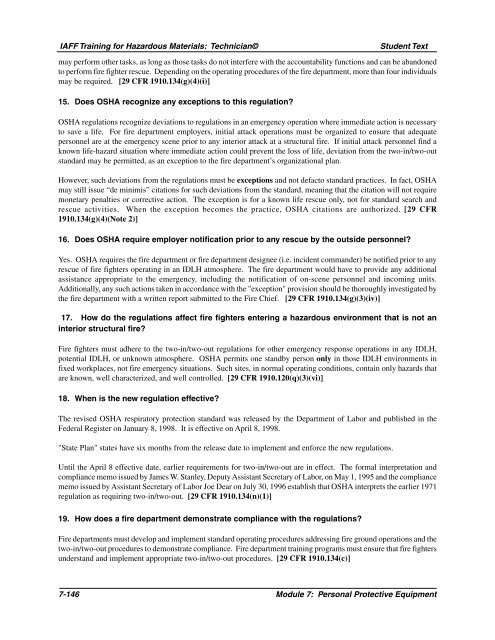Module 7 - IAFF
Module 7 - IAFF
Module 7 - IAFF
You also want an ePaper? Increase the reach of your titles
YUMPU automatically turns print PDFs into web optimized ePapers that Google loves.
<strong>IAFF</strong> Training for Hazardous Materials: Technician©<br />
Student Text<br />
may perform other tasks, as long as those tasks do not interfere with the accountability functions and can be abandoned<br />
to perform fire fighter rescue. Depending on the operating procedures of the fire department, more than four individuals<br />
may be required. [29 CFR 1910.134(g)(4)(i)]<br />
15. Does OSHA recognize any exceptions to this regulation?<br />
OSHA regulations recognize deviations to regulations in an emergency operation where immediate action is necessary<br />
to save a life. For fire department employers, initial attack operations must be organized to ensure that adequate<br />
personnel are at the emergency scene prior to any interior attack at a structural fire. If initial attack personnel find a<br />
known life-hazard situation where immediate action could prevent the loss of life, deviation from the two-in/two-out<br />
standard may be permitted, as an exception to the fire department’s organizational plan.<br />
However, such deviations from the regulations must be exceptions and not defacto standard practices. In fact, OSHA<br />
may still issue “de minimis” citations for such deviations from the standard, meaning that the citation will not require<br />
monetary penalties or corrective action. The exception is for a known life rescue only, not for standard search and<br />
rescue activities. When the exception becomes the practice, OSHA citations are authorized. [29 CFR<br />
1910.134(g)(4)(Note 2)]<br />
16. Does OSHA require employer notification prior to any rescue by the outside personnel?<br />
Yes. OSHA requires the fire department or fire department designee (i.e. incident commander) be notified prior to any<br />
rescue of fire fighters operating in an IDLH atmosphere. The fire department would have to provide any additional<br />
assistance appropriate to the emergency, including the notification of on-scene personnel and incoming units.<br />
Additionally, any such actions taken in accordance with the "exception" provision should be thoroughly investigated by<br />
the fire department with a written report submitted to the Fire Chief. [29 CFR 1910.134(g)(3)(iv)]<br />
17. How do the regulations affect fire fighters entering a hazardous environment that is not an<br />
interior structural fire?<br />
Fire fighters must adhere to the two-in/two-out regulations for other emergency response operations in any IDLH,<br />
potential IDLH, or unknown atmosphere. OSHA permits one standby person only in those IDLH environments in<br />
fixed workplaces, not fire emergency situations. Such sites, in normal operating conditions, contain only hazards that<br />
are known, well characterized, and well controlled. [29 CFR 1910.120(q)(3)(vi)]<br />
18. When is the new regulation effective?<br />
The revised OSHA respiratory protection standard was released by the Department of Labor and published in the<br />
Federal Register on January 8, 1998. It is effective on April 8, 1998.<br />
"State Plan" states have six months from the release date to implement and enforce the new regulations.<br />
Until the April 8 effective date, earlier requirements for two-in/two-out are in effect. The formal interpretation and<br />
compliance memo issued by James W. Stanley, Deputy Assistant Secretary of Labor, on May 1, 1995 and the compliance<br />
memo issued by Assistant Secretary of Labor Joe Dear on July 30, 1996 establish that OSHA interprets the earlier 1971<br />
regulation as requiring two-in/two-out. [29 CFR 1910.134(n)(1)]<br />
19. How does a fire department demonstrate compliance with the regulations?<br />
Fire departments must develop and implement standard operating procedures addressing fire ground operations and the<br />
two-in/two-out procedures to demonstrate compliance. Fire department training programs must ensure that fire fighters<br />
understand and implement appropriate two-in/two-out procedures. [29 CFR 1910.134(c)]<br />
7-146 <strong>Module</strong> 7: Personal Protective Equipment
















